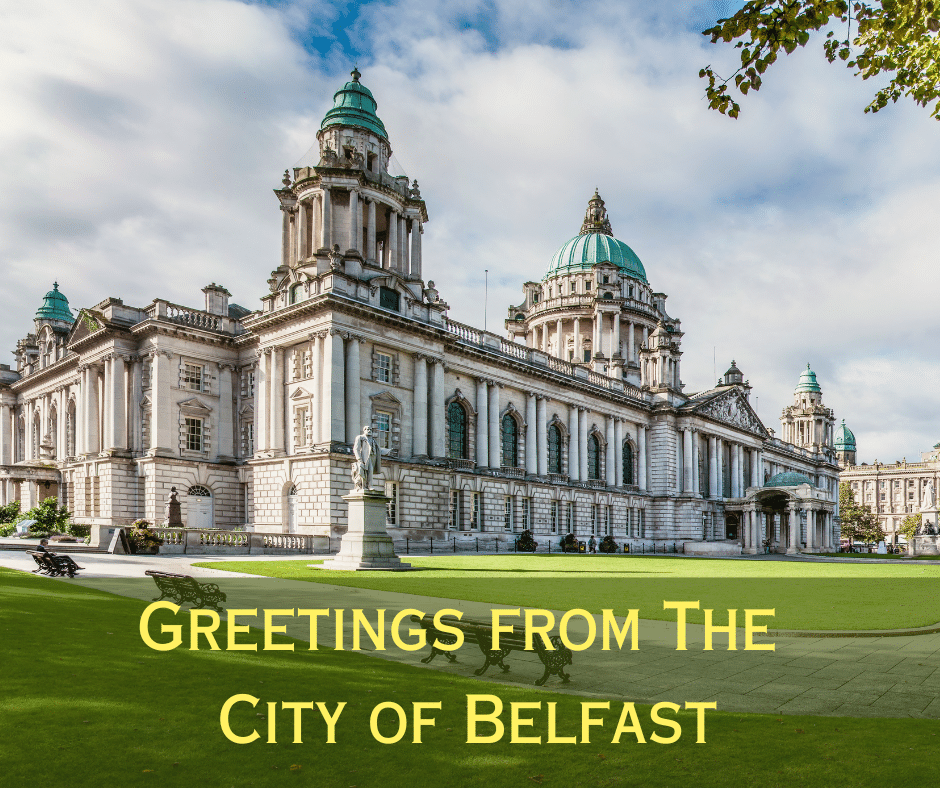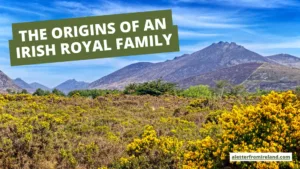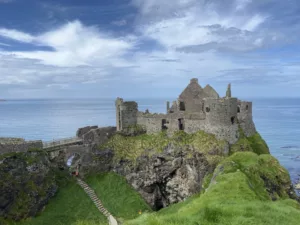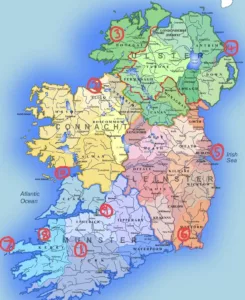The City of Belfast
Explore the city of Belfast's unique history and its divergence from other Irish cities. Through a conversation with our Belfast-born genealogist, Jayne McGarvey, we'll delve into the lives of ancestors, the events that moulded them, and the reasons behind their migrations.

BELFAST – THE MOVIE AND THE CITY.
Did any of your Irish ancestors live in an Irish city? Many of the cities – such as Dublin, Cork, Limerick, Wexford and Waterford – were founded originally as ports for winter layover by the Vikings but grew over time into trading hubs that attracted many of our shared Irish ancestors from the countryside that surrounded these cities.
Belfast was an exception – it was founded as a commercial trading port in the 1600s. While we’re often asked to help source records for your Irish ancestors in the Green Room, we’re also often asked what life might have been like for their ancestor at that time. What were the historical events that affected a place where an ancestor lived? What were the social and economic pressures of the time that caused them the leave one place and go to another – or emigrate for good?
Before we look a little closer at the history and development of Belfast, have you seen the movie going by that name – “Belfast”? It was written by Kenneth Branagh, a native of Belfast himself who moved to England with his family when The Troubles began in the late 1960s. The film has received wonderful reviews – despite feeling a mite cheerful at times for those of us who remember the dark days of the 1970s and 1980s in that part of Ireland. Here’s the trailer to this very personal celluloid memoir:
Now that looks like a good story! Back to the city of Belfast.
Recently, I notice such an exchange between Colleen (one of our Green Room members) and Jayne McGarvey – our Irish Green Room genealogist. Colleen wanted to learn more about the place where her Irish ancestors once lived – the city of Belfast. And who better to answer than Jayne, who was born in Belfast and lives just outside the city today.
So, over to Colleen and Jayne – I hope you enjoy Jayne’s summary of the establishment and growth of her home city.
Colleen:
My 2x grandfather Thomas McCurry is from Antrim County, somewhere around Belfast. Since he is Roman Catholic, I have wondered about my former belief that he was transplanted here from Scotland via the Ulster plantation – I thought that the English transported protestants only, as they wanted to make Northern Ireland, primarily protestant.
The other possibility is that he was Roman Catholic and was driven out of the Belfast area because of religious persecution (besides the hunger) and dreamt of a better life in Canada. I’d like Jayne McGarvey to comment on this and give me “the bigger picture”, so I could understand the Ulster plantation a little better.
Jayne McGarvey’s reply:
Hi Coleen,
The name Belfast is an anglicisation of the Gaelic words “Béal Feirste” meaning “mouth of the sandy ford”. The town of Belfast did not exist until 1609 when King James began a policy of settling English and Scots families in the province of Ulster. Sir Arthur Chichester was granted land in Ulster around Belfast Castle (originally built by the Normans in the 1100s), which he then rebuilt in 1611 – and a small town soon grew up in the shadow of this castle.
In 1611 there was a combination of Englishmen, Scots and Manxmen (Isle of Man) all living in the newly thriving community of Belfast. By 1613, Belfast was made a corporation and soon afterwards sent two members to parliament. However, this corporation remained partly controlled by the Chichester family, who were the “lords of the manor”. Belfast was run by an official called a “sovereign” who was assisted by twelve burgesses (merchants). Each year the burgesses drew up a short list of three of themselves and Chichester chose one to be the sovereign. In 1660 Belfast is reported as having 5 streets, 5 lanes and 150 houses.
Six years later 204 houses were recorded and rated for Hearth Money.
The Penal laws were established in the early 1700s and certainly did affect Belfast. Initially, Catholics were excluded from living in the town and there was an exclusion of Catholics from most public offices. Presbyterians were also barred from public office from 1707 which caused a bit of a stir in Belfast as the majority (I think 10 out of 12) burgesses were Presbyterian and had to resign their positions. The 1732 census of the Barony of Belfast recorded 4,532 Protestant and 340 Roman Catholic families.
In the late 1700s, the Presbyterian and Church of Ireland took up special collections at their services specifically to raise funds for the building of the first Catholic Church in Belfast. St. Mary’s (which still stands today), celebrated its first Mass on 30th May, 1784.
Even in the early days Belfast was a busy little trading port and the early Port Books offer a fascinating insight into the vast array of goods that came and went via its small docks. The place acted as a magnet and drew people from many other parts of the island – and swelled further with a group of French Protestants (known as the “Huguenots”) who fled persecution in their own country in the late 17th Century. They are attributed with bringing linen production to the city.
The linen was woven in people’s homes in the surrounding countryside – not woven in factories. In 1701 less than 200,000 yards of linen was exported from Belfast. By 1773 the figure had risen to 17 million yards. Cotton spinning was introduced into Belfast in 1777 and the White Linen Hall was built in 1788.
The Belfast Ballast Board, later to become the Belfast Harbour Commissioners, was set up in 1785. They immediately began the process of straightening the river Lagan that flowed through the city. William Ritchie – a shipbuilder from Ayr, Scotland – visited in March of 1791 with a view to new business opportunities and returned later that year with 10 skilled workmen and his younger brother Hugh to open a shipyard on the site of the Old Lime Kiln Dock (later to become Clarendon Dock No 1). The records show that there were less than 10 skilled carpenters in Belfast at this time. That soon changed. Belfast became a major ship-building centre within the empire – which included the building of the ill-fated Titanic in the early 1900s by Harland and Wolff shipbuilders.
Belfast continued to grow – but only became a city in 1888. Northern Ireland – as a separate state from the Republic of Ireland – did not exist until 1921.
If you would like some help to look more closely at your own family, and what was happening around them why not pop over to the Ask a Genealogist section of the Green Room forum and we can take a look in more detail about what you know, and what you would like to find out.
I hope you find this “bigger picture” of our shared ancestral city useful!
Jayne.
Thank you very much to Colleen and Jayne for that exchange. It’s always fascinating to get an insight into the major forces that shape a city over the centuries – and see just how some of those forces may have affected our ancestors.
How about you? Did any of your Irish ancestors live – or travel through – the City of Belfast in Ireland? Do leave a comment below to let us know.
Slán for this week,
Mike.







Only Plus Members can comment - Join Now
If you already have an account sign in here.